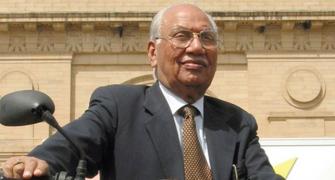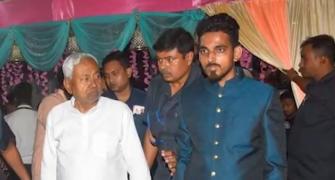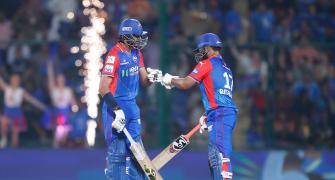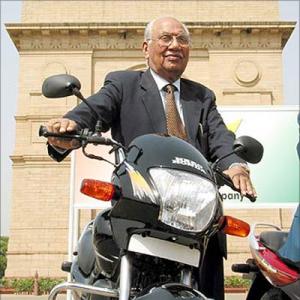Brijmohan Lall Munjal, who died recently, changed the dynamics of the motorcycle industry by introducing fuel-efficient, low-maintenance Japanese bikes in the early 1980s.
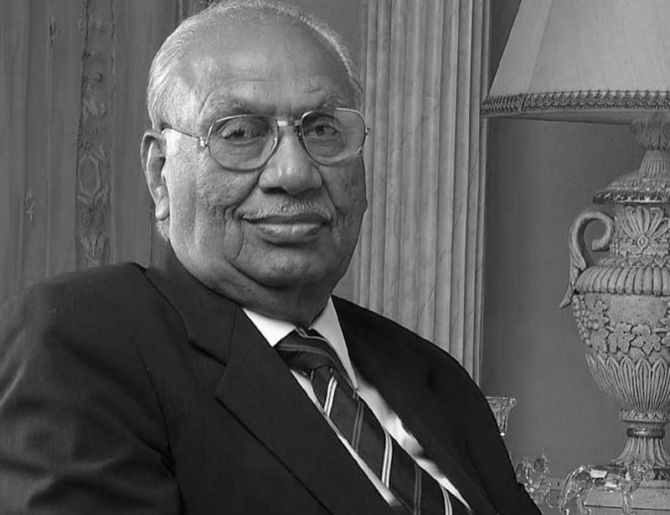 Those were the days my friend… we thought they would never end…," crooned Mary Hopkins back in 1968. In those days, smart young men had just graduated from big 4-stroke imported bikes like BSA, Triumph, Norton, BMW and even the American monsters like Harley Davidson and Indian Chief to the little Lambretta and Vespa scooters.
Those were the days my friend… we thought they would never end…," crooned Mary Hopkins back in 1968. In those days, smart young men had just graduated from big 4-stroke imported bikes like BSA, Triumph, Norton, BMW and even the American monsters like Harley Davidson and Indian Chief to the little Lambretta and Vespa scooters.
The Lamby faded out and the Vespa evolved into the Bajaj that quickly became the mainstay for almost every bureaucrat.
With the lumbering Ambassador and Fiat cars, it ruled the Indian roads throughout the 1970s, while the Rajdoot and Jawa as well as the old Royal Enfield motorcycles trailed far behind.
I began my motoring on a curious American 300 cc Allstate scooter and later graduated to a 500 cc 4-stroke Jawa that I rescued from a junk heap.
In 1970, I joined Escorts that used to make the 175 cc Rajdoot. By this time small Japanese bikes had revolutionised the global roads but none of the Japanese manufacturers was willing to part with its technologies.
In 1977, Escorts persuaded Yamaha to sell its technology for the 2-stroke 350 cc Yamaha RD 350 motorcycle because it was phasing it out.
The twin cylinder bike was one of the world's fastest road bikes but was way ahead of its time and was not a success, even though it taught Escorts a great deal about Japanese engineering and systems.
Escorts also discovered that to make this bike, it had to enter into technical collaborations with eight other Japanese companies for carburetors, clutch assemblies and even the spokes for the wheels.
Conventional wisdom at the time had it that the 4-stroke technology was best for engines above 200 cc and that smaller bikes should use 2-stroke engines.
In 1980, the government decided to allow 100 cc motorcycles and issued licences to four bike-makers.
Suzuki was first off the mark in collaboration with Kinetic Engineering in 1983.
It did very well until Honda collaborated with cycle-maker Brijmohan Lall Munjal of Hero to introduce the 4-stroke 100 cc CD100 the following year.
Critics claimed that it was too complicated for India's after-sales service but its extraordinary fuel efficiency, captured in its memorable slogan, "Fill it, Shut it, Forget it", made it an instant hit.
Those Japanese bikes The Yamaha RX100 entered the market next, in 1985.
Though 2-stroke, it belted out a huge 11 bhp as compared to the 7.5 bhp of the Hero Honda CD100. It got off to a slow start with its higher fuel consumption but gradually became the preferred bike for youngsters who wanted its phenomenal speed and performance.
A year later, Bajaj Auto introduced Kawasaki's KB100 that was not a great success because Hero Honda had captured the space of buyers who wanted economy and Yamaha had the market among those who wanted performance.
Hero Honda's CD100 and successor bikes not only offered outstanding fuel efficiency with adequate performance but also proved to be very reliable. After that, all 2-stroke engines came under a cloud with concerns about pollution and had to be phased out.
Hero Honda, therefore, flourished despite growing competition from home grown 4-stroke bikes made by TVS and Bajaj Auto and from Yamaha, which was now an independent foreign company in India.
Bajaj Auto parted company with its collaborator, Piaggio, which owned the Vespa brand. Piaggio formed a new collaboration with LML to continue with the making of its famous product.
They both did well for a few years until they began to lose ground when faced with the onslaught of so many good 100 cc motorcycles.
And both companies suddenly stopped scooter production.
After that, Suzuki tied up with TVS, while Kinetic tied up with Mahindra & Mahindra after trying to battle it alone for several years.
It was very difficult for small companies to survive in intensely competitive markets.
Those Japanese bikes With the loosening of government controls, foreign companies were allowed to build or import their models.
Suzuki Motorcycles, as a 100 per cent foreign company then, began to fill the gap, making a range of scooters.
It was followed by scooters from Honda, which had separated from Hero in 2011.
The excellent scooters from this new company made them a great hit.
The scooter now began to revive and made inroads into the huge motorcycle market. Today, scooters are growing fast and account for nearly 30 per cent of India's two-wheeler sales.
After China, India is now the world's largest two-wheeler market with an annual sale of over 19 million units.
All the bike and scooter companies broke out of the 100 cc restrictions of the past and bigger bikes and scooters began to be offered to Indian buyers.
In warm countries like India, China, Southeast Asia and southern Europe, the two-wheeler mostly serves as a commuting vehicle.
That's where the volumes are. Big bikes, which often cost as much as a car, are mostly "boy toys" for the rich and sporty living of cooler climes.
India had long been a market for commuting bikes and few Indian customers were interested in big machines.
When the BMW 650 cc Funduro was launched in the late 1990s, it had great difficulty selling 80 machines, but there are several sporty buyers today who are going for big bikes imported by Harley Davidson, Honda, Kawasaki, Yamaha, Suzuki and Triumph - despite the heavy customs duty they have to pay.
There is nothing like riding a big bike to pump by the adrenaline - and to catch the attention of pretty girls.
Photograph: Hero MotoCorp


